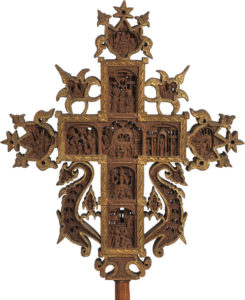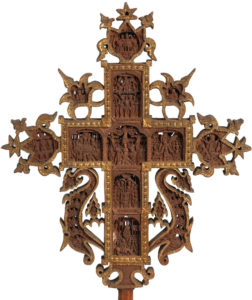Preparing the Mount Athos cross for its first ever public display at The Courtauld Gallery was no mean feat. This object from the 17–18th century may not be shy, but it was in need of conservation prior to its 2012 relocation from store to gallery floor. The beautifully carved cross was likely made in one of the many monasteries around Mount Athos and decorated with episodes from the Old and New Testaments. Eleni Dimitriadou explores the intricately carved scenes in each of the object’s niches, and looks at their significance for Orthodox Christian congregations.
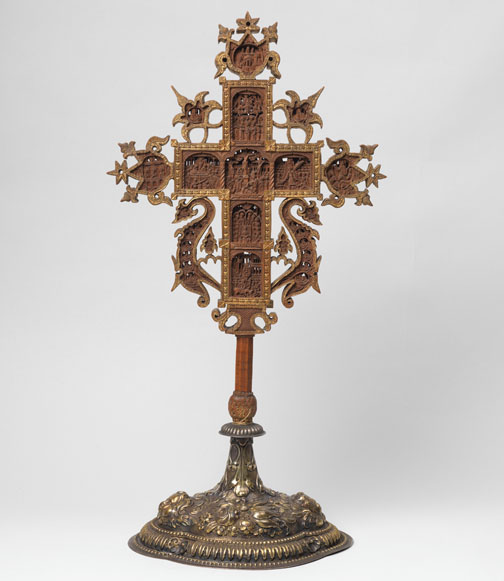
Making and Meaning in Mount Athos Crosses
Looking at the cross, immobile in its glass case, one might easily forget its key role in the daily life and rituals of the Orthodox Church. The object is designed for use in the benediction of the congregation during the liturgy. The origins of the cross are slippery. While we can localise its probable place of manufacture to Mount Athos in northern Greece, finding a production date is more elusive. A large number of crosses of this type are kept in the celebrated monasteries of Athos, of which the oldest building dates to 963 CE. Mount Athos was a centre of miniature woodcarving between the 16–18th centuries, and this craft is still practised by monks on Athos today. It was once thought that The Courtauld’s cross was from the 18th century (with a nineteenth-century stand), but we have grounds to place it around a century earlier. Giveaways include the large size of the cross, the added elements to the edges of its arms and in the spaces between them, as well as the absence of metal revetment, which is a kind of casing.
The main body of the cross shows significant events from the life of Christ and the Virgin. The annual celebration of these events makes up the Great Feasts Cycle of the Orthodox Church, known as the Dodekaorton in Greek. The elaborate shapes that project out from the cross are carved with Old Testament narratives and images of prophets and saints. A pair of Greek acronyms referring to the salvation of mankind can be seen on the lateral sides of the cross.
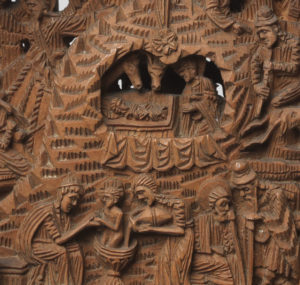
Each scene is identified by a relief inscription in Greek, set underneath an arched opening, and depicted with an architectural backdrop. The selection and ordering of episodes — the programme — has been chosen with care. The carver does not show the life of Christ and the Virgin with accurate chronology, but rather he positions important events at centre stage. For instance, the central compositions on each face of the cross show Christ’s entry into the world, and the circumstances of his departure: the Nativity is on one side (A), and the Crucifixion on the other (B). This is a potent opposition of life and death, which is all too pertinent to the symbolism of the cross.
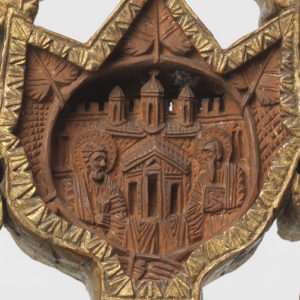
A scene which does not really fit into the wider stories illustrated by the cross, since it does not derive from the Bible, is that of the Apostles Peter and Paul holding a model of a church. It is carved inside the uppermost finial (side B). This theme, popular in post-Byzantine art, is thought to symbolise the union of the Orthodox and Catholic Churches.
The horizontal arms of the cross (side B) bear a sequence of scenes that evoke the idea of human redemption through death. For example, from left to right we see: the death of the Virgin, the Crucifixion, and Christ’s triumphant descent into hell following his death and prior to his resurrection. The idea of the redemption of mankind through sacrifice is also underlined by the acronyms incised onto the thickness of the arms of the cross: ‘ΤΚΠΓ’ standing for ‘The Place of the Skull has Become Paradise’; and ‘ΑΠΜΣ’ meaning ‘the Cross is the Beginning of the Sacrament of Faith’.
Forge your own path through these narratives by clicking on sections of the cross below! Each part of the object can be expanded, with a description there to help you in decrypting the images:

